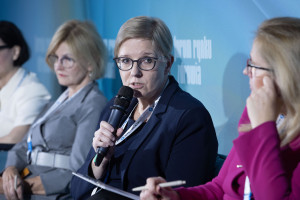Poles in the grips of cancer. The latest report reveals who gets sick most often

- The National Institute of Public Health – National Research Institute published the report "The health situation of the Polish population and its determinants – 2025"
- According to the report, over the past 50 years, the number of cancer diagnoses in men has increased by over 55,000, to nearly 90,000 per year, and in women it has increased by almost 61,000, to 91.5 thousand per year.
- Men most often get prostate cancer, lung cancer, and colon cancer. In women, the most common cancers are breast cancer, colon cancer, and lung cancer.
- In recent years, changes in the incidence of tobacco-related cancers have been observed. A decrease is visible in men, while an increase is visible in women.
The National Institute of Public Health – National Research Institute published the report "The health situation of the Polish population and its determinants – 2025" , which also takes into account trends in cancer incidence.
As the authors of the report point out, over the last half-century, i.e. in the years 1980-2022, there has been an increase in the incidence of cancer in Poland: in men, the number of cancer diagnoses increased by over 55,000 , from over 34,000 to nearly 90,000 per year, and in women it increased by almost 61,000 - from 30,000 to 91.5 thousand.
Over the last 50 years, the most common cancers in men were: stomach cancer, which was dominant until the early 1970s, lung cancer, the incidence of which increased until the mid-1990s, and prostate cancer, which has been the most common cancer since 2016.
In 2022, the following were recorded in men:
- nearly 21 thousand cases of prostate cancer (over 23 percent of cancer cases), while in 1980 there were about 1.7 thousand (less than 6 percent);
- In second place is lung cancer : 12.3 thousand cases in 2022 (nearly 14% );
- in third place – colon cancer – 10.4 thousand cases (nearly 12 percent ).
Among women, the most common cancer 50 years ago was cervical cancer. Currently, according to data from 2022, the most common cancers are:
- breast ( 21.5 thousand cases, nearly 24% );
- large intestine ( 8.7 thousand cases, nearly 10% );
- lungs ( 8.4 thousand cases, 9% ).
Cancers in children (0-19 years) are rare: 1,000-1,200 cases per year, with the structure of the disease differing from that observed in adults. Leukemias, lymphomas and brain tumors constitute almost 60 percent of the cases. A slight tendency towards an increase in the incidence is visible in both boys and girls.
The situation is different for young adults (20-44 years old ), where the incidence rates for women are almost twice as high as for men. This difference has been increasing since the 1980s, and since the beginning of the 21st century, the increase has begun to accelerate.
In 2022, the most common cancers in young men were: testicular ( 24% ), colon (7% ), and melanoma ( 6% ). In young women, the most common were breast ( 28% ), cervical ( 5% ), ovarian (4% ), and colon (4% ) cancers.
In the middle-aged group (45-64 years), the incidence of women has exceeded that of men since 2010. Among men of this age, the most common cancers are: prostate cancer ( 20% ), lung cancer (13% ) and colon cancer (12% ). In the middle-aged female population, the most common cancers are: breast cancer ( 31% ), endometrial cancer (8% ) and lung cancer ( 7% ).
In the oldest age group (65+), a slowdown in the growth of cancer incidence has been observed in both sexes in the last decade. In 2022, the most common cancers in men over 65 were: prostate ( 27% ), lung ( 15% ) and colon ( 12% ). In the oldest age group of women, the most common cancers were: breast ( 19% ), colon ( 12% ) and lung ( 12% ).
Tobacco-related cancers: Decrease in men, increase in womenIn recent years, changes in the incidence of tobacco-related cancers have been observed. A decrease is visible in men, while an increase is visible in women.
In the case of men, the largest increase in morbidity is prostate cancer and melanoma, but lung cancer has already seen a long-term downward trend - since 1995, there has been a 50% decrease in morbidity. A similar trend is visible in the case of larynx cancer, which has been helped by a lower incidence of tobacco smoking. The incidence of stomach cancer is also decreasing. Since 2016, the increase in the incidence of colon cancer has also clearly slowed down.
In the female population, decreasing incidence trends are observed only for stomach and cervical cancer. The highest growth rates are observed for breast, lung, endometrial and thyroid cancers .
The postal code mattersAs the authors of the report note, place of residence influences the risk of cancer in both sexes and in all age groups.
The incidence of disease among rural residents is lower than among urban residents, with the smallest difference being characteristic of middle-aged people (45-64 years old). In the group of young people, both in rural and urban areas, the risk of disease is higher for women than for men.
Since 1999, the incidence of the disease has been increasing among residents of both cities and villages, with the greatest increase occurring among women living in rural areas.
Copyrighted material - reprint rules are specified in the regulations .
rynekzdrowia












